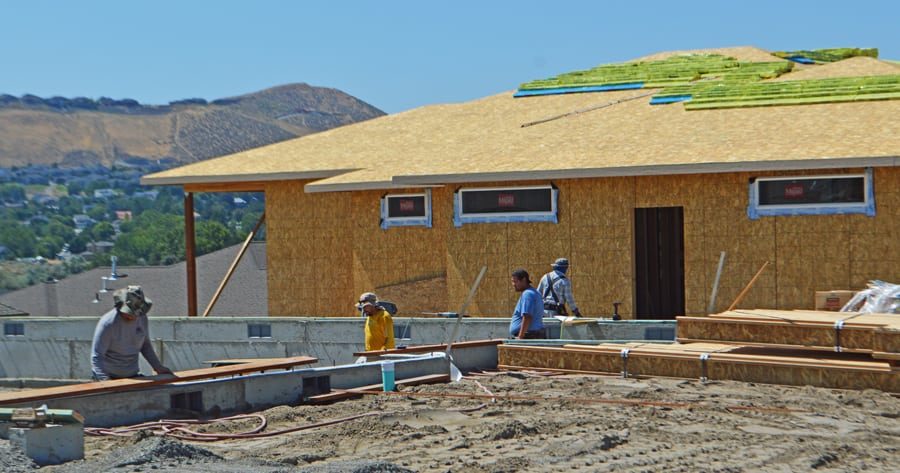
Home » Materials, fees pushing up cost of Tri-City homes
Materials, fees pushing up cost of Tri-City homes

August 14, 2018
The rising price of building materials and other costs continues to drive up the price of new homes being built in the Tri-Cities, pushing sale prices up as much as 20 percent in some cases.
“I’m building the same home right now that I finished on a different lot two years ago and the same home costs $15,000 more to build,” said Kyle LaPierre, owner of LaPierre Enterprises.
He says the lumber and truss packages cost him significantly more than they once did because of taxes levied on Canadian lumber.
The National Association of Home Builders reports that framing lumber and the cost of installing it amounts to about 18 percent of a home’s selling price.
“Everything gets passed on to the consumer,” LaPierre said. Cutting labor costs isn’t as simple since that’s where builders find profit margins, and builders aren’t forced to eat the cost of higher materials while the local housing market is still hot.
Costs are also rising locally due to a shortage of available lots.
Jeff Losey, executive director of the Home Builders Association of Tri-Cities, said there’s been a slowdown on platting subdivisions, a government process that allows lots to become available to builders and developers. This can leave consumers with fewer options for builder choices since most available lots are already owned. Buyers may be limited to build exclusively with the company that currently owns the lot.
“If you want a custom home and don’t have the land already, it’s going to be tough,” Losey said. The increased demand has driven up the cost of lots just in the past 10 years.
Losey said a typical developed lot of about 7,500 square feet to 10,000 square feet costs between $25,000 to $35,000 a decade ago. Similar lots today cost between $70,000 and $90,000 and the price gets factored into the total cost of the price of a home.
“Within the last few years, it used to be, ‘What can you build for $150 a square foot?’ Now, it’s not uncommon for a build to be $200 a square foot, with one of the biggest contributors locally being the cost of land,” LaPierre said.
That total cost for a new home is higher, in part, because of a White House decision to place import taxes on softwood lumber from Canada, including spruce, fir and pine.
Tariffs of nearly 21 percent took effect in late 2017 with the intention of boosting the American lumber market. But Losey said it’s not as simple as flipping a switch from Canadian lumber to American lumber.
“Having a lot of the mills closed during prior administrations, for them to catch up to demand now just isn’t easy to do,” he said.
The National Association of Home Builders blames the new lumber import taxes alone for a nationwide home price increase of nearly seven percent, or an average of $1,360.
Losey contends that it’s not just the cost of lumber, but the increasing price of products like aluminum and steel.
“As they affect the entire market, it’s still going to trickle down to the home-building industry,” he said.
Even something as simple as aluminum tie-down straps can cost more. Not to mention the steady increase of fuel for companies traveling to job sites.
Dan Vargo, owner of Vargo Construction, said all the back and forth driving to pick up materials or plan for a job can erode his profit margins.
“I can be a thousand dollars into a job before I even start,” he said.
The price of oriented strand board has also risen 30 percent in the past year, according to the Bureau of Labor Statistics. This plywood alternative is used in most new homes today since it is typically cheaper and stronger than traditional plywood.
“As much as home costs are going up as far as the cost of supplies, in our Tri-Cities region it hasn’t slowed the growth of new homes being built,” Losey said. “It just costs the consumer more to purchase a house today than it did a year or two years ago. And that cost inflation factor is rising faster than it did in years prior.”
It also costs current homeowners more to remodel a home, with projects that aren’t always dependent on lumber.
Vargo cited the rising costs of steel and concrete as impacting his business.
“I get a letter from American Rock (Products) every six months telling me the price of concrete is going up,” he said. He used to pay $70 a yard for concrete and now it’s up to $118 a yard. “Put it on top of the cost of everything else. You can’t reduce the price of labor or you don’t make anything, but you might have to reduce it in order to remain competitive,” Vargo said. “For most people, their paycheck isn’t negotiable, but for construction labor ours certainly seems to be.”
Labor and materials aren’t the only factors driving the cost of homes in the Tri-Cities, as the permits for new homes have been subject to impact fees designed to offset the effects of people living in those new homes, including added traffic on roads and students in schools from all the people.
A $4,700 fee is added to the cost of every new home permit in Pasco, and Kennewick recently began a traffic impact fee for homes built within its city limits. The cost varies depending on the location of the home, with the highest fees being in Southridge, adding $1,311 to the price of a home permit. Richland is expected to levy its own traffic impact fee soon, which could range from $854 to $2,229, depending on the area of town. Homes built in the Badger Mountain south area, near Dallas Road and Interstate 82, could be subject to the highest fees.
The increasing costs have continued to make the Tri-City housing market beneficial for sellers versus buyers.
The local market has averaged 500 available homes for sale in recent months, while typical market availability has been about 1,200 homes listed at any one time.
“We still can’t move the needle as far as homes on the market,” Losey said. For those looking to leave the Tri-City area, they can benefit from the sellers’ market, but for those who might sell and stay local, they’ll have to buy back into the market at a higher rate than found previously. Local builders are still cranking out 2,000 to 2,200 new homes in a single year.
“Homes are being sold almost as quickly as they’re being built,” Losey said.
Homes can’t be built much faster than they currently are, due to the limited number of qualified workers available.
“Our Achilles’ heel for the construction industry is skilled labor. There isn’t enough skilled trade labor coming into the market to help offset our aging construction work force,” Losey said. “If there’s an opportunity to build more homes, there isn’t enough workers. Keeping up with the demand is not very possible right now due to the shortage in labor.”
Locally, industry groups like Losey’s are working with Tri-Tech Skills Center in Kennewick and Pasco High School to introduce high school students to the building industry to drum up interest in future construction careers.
On the national level, “we would advocate for temporary visas for workers to be able to come in, and get back out, all doing it the right way. That could provide some needed relief on labor,” Losey said. “We’re years away from the construction work force getting anywhere near back to normal. It could get worse before it gets better.”
Real Estate & Construction Local News
KEYWORDS august 2018





